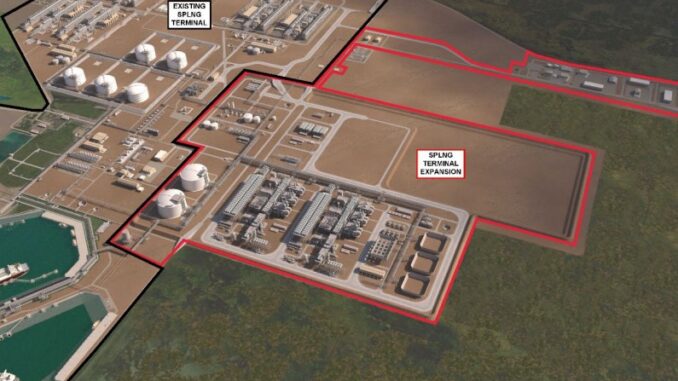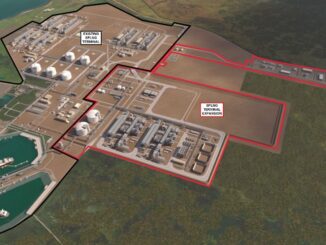
US LNG exporting giant Cheniere now plans to build two instead of three liquefaction trains as part of the Sabine Pass expansion project in Louisiana.
Sabine Pass currently has a capacity of about 30 mtpa following the launch of the sixth train in February last year, while Cheniere’s three-train Corpus Christi plant in Texas can produce about 15 mtpa of LNG and is undergoing expansion.
Earlier this year, Cheniere initiated the pre-filing review process with the US FERC for the Sabine Pass Stage 5 expansion project.
The original plans included the construction of three large-scale liquefaction trains, each with a production capacity of about 6.5 mtpa of LNG, a boil-off-gas (BOG) reliquefaction unit with a production capacity of 0.75 mtpa of LNG, and also two 220,000-cbm LNG storage tanks.
However, Cheniere now aims to construct two LNG trains with a nameplate capacity of about 7 mtpa each using ConocoPhillips liquefaction technology, according to a draft resource report filed with the FERC in November.
The Houston-based firm did not say why it decided to reduce the size of the planned expansion project.
LNG Prime invited Cheniere to comment on the matter.
The proposed Sabine Pass expansion facilities will be interconnected and operated with the existing terminal, while Cheniere is also proposing an increase in the authorized maximum loading rate of LNG carriers and simultaneous loading capabilities for the three existing jetties.
Sabine Pass is proposing to increase loading to about 14,000 cbm per hour of LNG from the two new storage tanks to the existing marine berths.
To deliver about 2.5 billion cubic feet per day (Bcf/d) of natural gas to the expansion project, Cheniere’s unit Sabine Crossing proposes to build a new, 48-inch diameter natural gas pipeline of about 5.3 miles in length extending from Jefferson County, Texas, and into the LNG terminal in Cameron Parish, Louisiana.
The Sabine Pass LNG terminal is currently authorized to produce and export 1661.94 Bcf/y of LNG (33.01 mtpa).
Cheniere said the expansion project would produce an additional 843.15 Bcf/y of LNG, equivalent to about of 16.83 mtpa of LNG for export or 2,050 MMscfd.
Also, the marine berths would be able to accommodate the total project exports of 49.84 mtpa, it said.
Cheniere said that engineering for the expansion project has progressed from preliminary design and is currently in the front-end engineering and design stage.
Cheniere engaged Bechtel to complete FEED.
Detailed engineering is expected to start in the third quarter of 2025, the firm said.
According to Cheniere, the LNG exporter aims to start construction in February 2026 and to complete it in October 2030.
The commissioning and launch of the new project is expected to be completed in June 2031.





